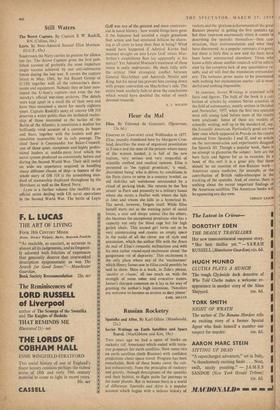Russian Rocketry Soviet Writings on Earth Satellites and Space Travel.
(MacGibbon and Kee, 18s.) Two years ago we had a spate of books on rocketry (all American) which ended with tenta- tive proposals for earth satellites. Now come two on earth satellites (both Russian) with confident predictions about space travel. Progress has been remarkable. Both of these books cover the sub- ject exhaustively, from the principles of rocketry and gravity, through descriptions of the sputniks and their habitat, to flight paths for journeys to the outer planets. But in between there is a world of difference. Sputniks and After is a popular account which begins with a tedious history of rockets and the 'glorious achievements of the gre Russian peoples' in getting the first sputniks t but then improves enormously when it comes describing the sputniks themselves—their co struction, their instrumentation and what th have discovered. As a popular summary it is goc but there is little that is new and the facts ha been better summarised elsewhere. Those wl know a little about satellite research will be inful ated by the complete lack of any quantitative r sults, and all will find the transhation extraordi ary. The tortuous prose seems to be punctual with nothing but exclamation marks—all is wo derful and nothing impossible.
In contrast, Soviet Writings is crammed wi facts and figures. The bulk of the book is a cc lection of articles by eminent Soviet scientists the field of astronautics, mostly written in Octob and November, 1957, when the first two sputni were still young (and before most of the resul were analysed). Some of these are models scientific writing, well up to the standard of, sa the Scientific American. Particularly good are tv later ones which appeared in Pravda on the resul obtained from Sputniks I and 11, and an artic on the instrumentation and experiments designs for Sputnik Ill. Though a popular book, there no attempt to glamorise the subject : here are tI bare facts and figures for us to examine. In book of this sort it is a great pity that the should be no mention of non-Russian work- American space medicine, for example, or tl contribution of British radio-telescopes in ti tracking of the sputniks. And, of course, there nothing about the recent important findings the American satellites. The American books w be appearing any day now.
GERALD LEAC






































 Previous page
Previous page